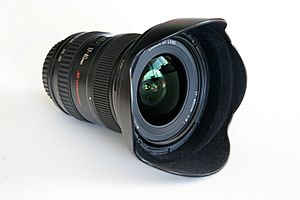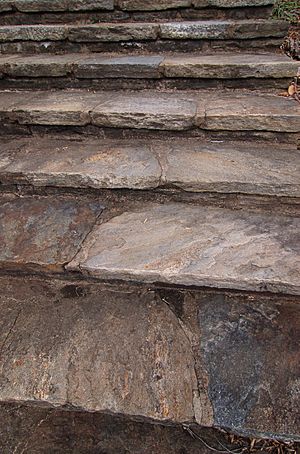Wide-angle lens facts for kids
A wide-angle lens is a special camera lens. It lets you capture a much wider area in your photos than a regular lens. Think of it like having a super-wide view!
Regular camera lenses usually see an area between 40 and 50 degrees wide. But a wide-angle lens can see a much bigger area. This is because it has a shorter focal length. The focal length is like how "zoomed in" or "zoomed out" a lens is. A shorter focal length means you can fit more into your picture.
Contents
What is Focal Length?
Focal length is a measurement, usually in millimeters (mm). It tells you how much of a scene a lens can capture. It also affects how big objects appear in your photo.
How Wide-Angle Lenses Work
A shorter focal length means the lens has a wider angle of view. This is the amount of the scene that the camera can "see." For example, a 50mm lens is considered a "normal" lens for traditional film cameras. It sees about 40-50 degrees.
A 35mm lens is a slight wide-angle lens. It can see about 63 degrees. A 28mm lens is even wider, seeing about 75 degrees. Lenses like 24mm, 20mm, or even 14mm are "ultra-wide." They can capture huge scenes, sometimes over 100 degrees!
Wide-Angle Lenses and Film Cameras
For old-fashioned 135 film cameras, a 50mm lens was considered "normal." This means it saw things much like the human eye. Lenses shorter than 50mm were wide-angle. For example, a 28mm lens was a popular wide-angle choice.
Wide-Angle Lenses and Digital Cameras
Things are a bit different with digital cameras. Many digital cameras have smaller sensors than film cameras. This means a lens will "see" a smaller area on a digital camera.
For example, an 18mm lens on a digital camera might give you the same wide view as a 28mm lens on a film camera. This is because of something called a "crop factor." The smaller sensor crops the image, making the lens act like a longer focal length.
Types of Wide-Angle Lenses
One very special type of wide-angle lens is a fisheye lens. These lenses are extremely wide. They often create a curved, distorted image. This makes the photo look like it was taken through a peephole or a fish-eye view.
Opposite of Wide-Angle Lenses
The opposite of a wide-angle lens is a Telephoto lens. Telephoto lenses have a long focal length. They are used to make distant objects appear closer and larger. They have a very narrow angle of view, meaning they capture only a small part of the scene.
Images for kids
-
How focal length affects photograph composition. Three images depict the same two objects, kept in the same positions. By changing focal length and adjusting the camera's distance from the pink bottle, it remains the same size in the image, while the blue bottle's size appears to dramatically change. Also note that at small focal lengths, more of the scene is included.
See also
 In Spanish: Objetivo gran angular para niños
In Spanish: Objetivo gran angular para niños




